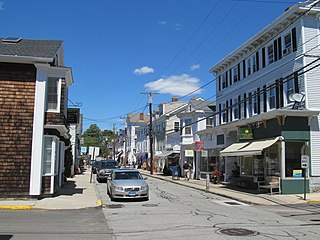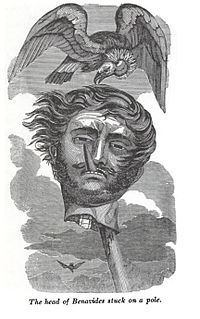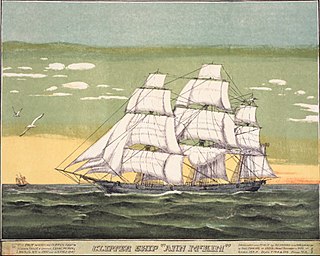Second voyage
Back in its Connecticut home port, the crew of the Hersilia quickly spread news of the recently discovered South Shetland Islands. The Fanning family organised a small fleet with fellow Stonington merchants to exploit the large seal populations there. Sheffield remained as captain and returned to the islands late in 1820. The Hersilia departed for Chile in February 1821 with a hold of over 15,000 seal furs. It was anchored at Santa María Island by May.
The crew was captured In the evening of the 14th, men loyal to Vicente Benavides captured the crew. Benavides was a royalist guerrilla leader in the Chilean War of Independence and was based out of the nearby Arauco. After sailing the Hersilia to the mouth of the Carampangue River, the majority of the sealers were taken to Arauco as prisoners. Benavides distributed the captured sealers among his own men, "one to each officer, to wait on, and serve them at their quarters, or in their families, as a menial slave..." Sheffield and another American captain were utilised by Benavides to write promissory notes to help finance his campaign.
The Hersilia was refitted by Benavides to serve as a warship. Its hold of seal pelts were taken to shore, and several cannon were brought aboard. With a complement of an approximately 100 men, the Hersilia sailed for the Chiloé Island settlement of Castro. While there additional funds and supplies for Benavides was ordered. Near Arauco the vessel became beached, with the Americans commanded to free the vessel. On the evening of September 26, the majority of them escaped under Sheffield on two whaling boats for Santa María Island. Storms and high gales kept them detained there for five days, with the men leaving for Valparaíso the following day. The Americans avoided landing on the coast until further north of the Bay of Concepción to avoid any pursuers. Starting at Maule they went overland and were given much needed foodstuffs by Chileans throughout their journey.
When the Americans finally reached Valparaíso, Sheffield held a conversation with the British commodore in charge of the South America Station, Sir Thomas Hardy. Informed of their months of captivity and abuse by Benavides, Hardy agreed to aid the Americans. A ship would be sent to Arauco so as to retrieve the Hersilia and the remaining Americans still there. The British warship HMS Conway was selected for the mission, with Sheffield sailing on board. When they reached Arauco, however, the British and Americans found the settlement ablaze. Soldiers loyal to the Republic of Chile had fought Benavides and forced him to retreat into the countryside. Prior to leaving his troops set fire to the Hersilia and various buildings in town, including the storehouses containing the seal pelts previously gathered by Sheffield's men. The remaining Americans that didn't previously escape the Royalist camp were found and rejoined their compatriots. Once back at Valparaíso, the Americans arranged for passage back to the United States. Notably the British officers gave funds to make this possible.

The town of Stonington is located in New London County, Connecticut in the state's southeastern corner. It includes the borough of Stonington, the villages of Pawcatuck, Lords Point, and Wequetequock, and the eastern halves of the villages of Mystic and Old Mystic. The population of the town was 18,335 at the 2020 census.

Nathaniel Brown Palmer was an American seal hunter, explorer, sailing captain, and ship designer. He gave his name to Palmer Land, Antarctica, which he explored in 1820 on his sloop Hero. He was born in Stonington, Connecticut, and was a descendant of Walter Palmer, one of the town's founders.

Elephant Island is an ice-covered, mountainous island off the coast of Antarctica in the outer reaches of the South Shetland Islands, in the Southern Ocean. The island is situated 245 kilometres north-northeast of the tip of the Antarctic Peninsula, 1,253 kilometres west-southwest of South Georgia, 935 kilometres south of the Falkland Islands, and 885 kilometres southeast of Cape Horn. It is within the Antarctic claims of Argentina, Chile and the United Kingdom.

The South Shetland Islands are a group of Antarctic islands with a total area of 3,687 km2 (1,424 sq mi). They lie about 120 kilometres north of the Antarctic Peninsula, and between 430 and 900 km southwest of the nearest point of the South Orkney Islands. By the Antarctic Treaty of 1959, the islands' sovereignty is neither recognized nor disputed by the signatories and they are free for use by any signatory for non-military purposes.

Livingston Island is an Antarctic island in the Southern Ocean, part of the South Shetlands Archipelago, a group of Antarctic islands north of the Antarctic Peninsula. It was the first land discovered south of 60° south latitude in 1819, a historic event that marked the end of a centuries-long pursuit of the mythical Terra Australis Incognita and the beginning of the exploration and utilization of real Antarctica. The name Livingston, although of unknown derivation, has been well established in international usage since the early 1820s.
Edmund Fanning was an American explorer and sea captain, known as the "Pathfinder of the Pacific."

Tonquin was a 290-ton American merchant ship initially operated by Fanning & Coles and later by the Pacific Fur Company (PFC), a subsidiary of the American Fur Company (AFC). Its first commander was Edmund Fanning, who sailed to the Qing Empire for valuable Chinese trade goods in 1807. The vessel was outfitted for another journey to China and then was sold to German-American entrepreneur John Jacob Astor. Included within his intricate plans to assume control over portions of the lucrative North American fur trade, the ship was intended to establish and supply trading outposts on the Pacific Northwest coast. Valuable animal furs purchased and trapped in the region would then be shipped to China, where consumer demand was high for particular pelts.

Rugged Island is an island 3 miles (4.8 km) long and 1 mile (1.6 km) wide, lying west of Livingston Island in the South Shetland Islands. Its surface area is 10.4 square kilometres (4.0 sq mi). The island's summit San Stefano Peak rises to 256 metres (840 ft) above sea level. Rugged Island is located at 62°38′S61°15′W. Rugged Island was known to both American and British sealers as early as 1820, and the name has been well established in international usage for over 100 years.
Captain Charles Barnard (1781–c.1840) was a famous castaway.

Luis Antonio Pardo Villalón was a Chilean Navy officer who, in August 1916, commanded the steam tug Yelcho to rescue the 22 stranded crewmen of Sir Ernest Shackleton's ship, Endurance, part of the Imperial Trans-Antarctic Expedition. The crewmen were stranded on Elephant Island, an ice-covered mountainous island off the coast of Antarctica in the outer reaches of the South Shetland Islands, in the Southern Ocean.
Union was constructed at Barnstable, Massachusetts, later purchased by Edmund Fanning, who refitted and registered the vessel in New York under ownership of Fanning & Coles shipping company partnership.

Cape Sheffield is a cape forming the northwest extremity of Rugged Island in the South Shetland Islands, Antarctica. It was named for Captain James P. Sheffield, Master of the brig Hersilia of Stonington, Connecticut, in 1819–20 and 1820–21, the first American sealer known to have visited the South Shetland Islands. In 1819–20 he took 8,868 sealskins from headquarters at Rugged Island.

Vicente Benavides Llanos was a Chilean soldier who fought in the Chilean War of Independence. He is best known for leading Royalists guerrillas in La Frontera during the last years of the war.

Benson Point is the ice-free headland forming the southwest extremity of Rugged Island in the South Shetland Islands, Antarctica. It is a northwest entrance point for Morton Strait. The area was known to early 19th century sealers.

Vietor Rock is a rock linked by a spit to Nikopol Point on the south coast of Byers Peninsula, Livingston Island in the South Shetland Islands, Antarctica. The area was visited by early 19th century sealers operating on Byers Peninsula.

Hersilia Cove is the 650 m wide cove indenting for 800 m the north coast of Rugged Island in the South Shetland Islands, Antarctica west of Herring Point.

HMS Conway was a Royal Navy sixth-rate post ship launched in 1814 as the lead ship of her class. The Royal Navy sold her in 1825 and she became the merchantman Toward Castle, and then a whaler. She was lost in 1838 off Baja California while well into her third whaling voyage.

Ann McKim was one of the first true clipper ships. The opening of new Treaty ports in the East in the early 1840s eased an access of the US merchants to China, which demanded the ships that could move cargo faster than then-traditional slow-moving, high-capacity merchant ships. The Ann McKim was one of the ships that had answered the demand in the early years and sailed between New York and China in 1840–1842, until newer and faster cargo-carriers, such as the nearly 600-ton clipper Houqua, the 598-ton China packet Helena, Witch of theWave, and Rainbow, with the last two built expressly to outperform the Ann McKim started dominating the shipping world of the US-China trade and the Ann McKim was shifted back to the South American trade routes.
Indian was launched in Massachusetts in 1805, possibly under the same name. She first appeared in British records in 1814, suggesting that she was a prize. She was Liverpool-based and traded widely, especially with South America. She was in Valparaiso in 1820 when news of the discovery of the South Shetland Islands and the sealing grounds there reached Valparaiso before it reached England. She sailed to the South Shetland Islands and gathered over 25,000 seal skins before returning to Liverpool. Thereafter, she returned to trading across the Atlantic. Her crew abandoned her in a waterlogged state on 17 August 1827.
Susanna Ann. was a smack launched at Bridport or Cowes in 1814, almost surely under another name. Between 1823 and 1833 she made six voyages as a whaler and sealer in the British southern whale fishery. From around 1834 on she traded with Africa, and then in 1838 she sailed to New South Wales (NSW). She moved her registry to NSW and traded between east coast Australian ports and with New Zealand until she was wrecked on 20 March 1847.











